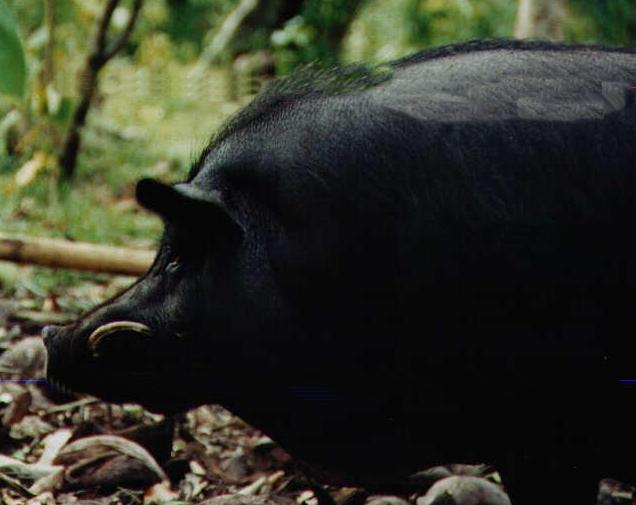|
|
GENETICS AND PHYSIOLOGY OF INTERSEXUALITY OF THE PIGS ON THE ISLANDS OF VANUATUVanuatu's intersex pigs combine features of both sexes, but are insufficiently developed for the purpose of reproduction. They, therefore, cannot be termed as true hermaphrodites. Hermaphrodites carry functional gonads of both sexes. The pigs represented on the Islands of Vanuatu are hence a unique form of intersexuality. These pseudo-hermaphrodites, or more correctly now, male pseudo-hermaphrodites, differ in the fact they invariably lack all rudiments of ovary, oviduct, womb, and vagina. These animals, then, can actually be classified as modified boars. From the earliest account(14), Baker states that the natives' story of the genetics of the abnormality neatly fits in with the assumption that it is caused by a sex-linked factor, intersexes being males carrying this factor. Intersex producing females ("falé-ravé" or "wurup kulaval" as they are referred to on the Sakau peninsula) would be hetero-zygous for the factor. Homozygous females can never occur in nature for they could only arise from the mating of two pigs, both of which carried the factor and this could never be the case without artificial insemination for the "would-be" males which carry the factor are intersexes whose copulatory organs are never sufficiently developed to function as such. Johnston(24) stated that the condition of intersexuality could be caused by a single pair of recessive genes, but other evidence indicates that the mode of inheritance is not that simple. With todays knowledge of genetics, the inheritance of the intersex trait may not be as straight forward as stated by baker. The mere fact that there aremany graduations of the condition (four phases identified during the King Naravé project, and the seven phases mentioned by the Sakau people)(4) suggests that it is almost certainly a polygenic trait with incomplete dominance. There is also a strong possibility of secondary modifier genes as either the sex or autosomal chromasomes effecting the expression of the trait. Their is obviously a more complex genetic explanation behind this condition. 
The Vanuatu intersexual condition is actually that of a male-pseudohermaphroditic individual whose embryonic testes have secreted their hormones at a "later" point in development than is necessary to hormonally produce a "normal male". Further I would like to theorize that the organs targeted by the secondary sexual characteristics require stimulation for development at a definite "critical" point in the embryonic development of that animal and that if that point is passed without the minimum stimulus of hormonal influence, then no amount of hormone released later will cause them to fully develop into the normal male condition. Uterus and vagina are not formed simply because there is never any ovarian tissue. The case of the "Feminine" pseudohermaphrodite, is simply a male in which the embryonic testes have developed much later than normal, after the vulva has already differentiated. The corpus cavernosum may develop and enlarge slightly and possibly modify the vulva, but essentially the external organ appears female condition. If the testes secrete their hormones earlier in the developmental time frame, the "Intermediate feminine" male pseudohermaphrodite will result. The corpus cavernosum will enlarge as much as 2 cm, and occasionally in this phase, the testicles are evident in the scrotum, although they do not appear to be fully developed. Even earlier development and hormone release will result in a condition in which normal sized testicles are fully descended into the scrotum but the enlarged urethral orifice ending is still situated below the anus, but closer to the testicles, and the vestigial vulva is reduced to a tiny slit. This phase will be referred to as the "tertiary feminine" male pseudohermaphrodite. The last phase, for which I only found one individual, was uniquely different. In this phase, the "transitional" male pseudohermaphrodite, the testicles were descended but a projection approximately 2 cm. long consisting of the ventral labial commissure, the corpus cavernosum, and the terminal part of the urethra, was situated near the anterior end of the scrotal region. Locals refer this as the "flying-fox" Naravé(4) as this genital configuration resembles that of the large native fruit bat (Pteropus sp.). What I suggest then is that these are all gradations of the same condition and differ only in the timing of hormonally-controlled developmental events. A similar account is given by the Sakau people, but their interesting classification of the Naravé separates them into 7 groups according to their external genitalia. They are as follows(4): 1. Ndré-rasa - The "feminine" intersex - The external appearance is essentially that of the female, except for the presence, in adults, of tusks. The testes are situated within the abdomen. 2. Ndré-runedh - "sprouting coconut" intersex - Small projection by the vulva, with testicles sometimes descended into scrotum. 3. Ndré-narsogh - "sewn up" intersex - occasionally the urinary projection is situated in the scrotal region but the urinary external orifice is occluded. Soon after birth locals would make a small incision to allow normal urination. 4. Ndré-ghara - "fruit bat" intersex - the urinary projection is long and situated at the back of the testicles resembling the genitalia of the local bat. 5. Ndré-nau - "rat" intersex - Genitalia resemble those of the rat. 6. Ndré-ghor-ghor - "hidden" intersex - The urinary projection is smaller like that of the Ndré-nau, but it is not visible when viewed from behind. 7. Ndré-selet - "worm" intersex - There is a further enlargement of the corpus cavernosum moving the projection yet further on the abdomen with a resultant "worm-like" extrusion from the end. These, as with the Authors classifications, commonly overlapped each other and at times
were difficult to categorize. There does, however, seem to be a genetic influence involved
in the inheritance of these conditions as certain families of animals in specific
localities show there is clearly an inherited tendency to certain phases of this
abnormality. |